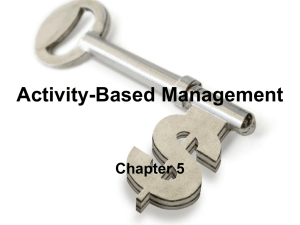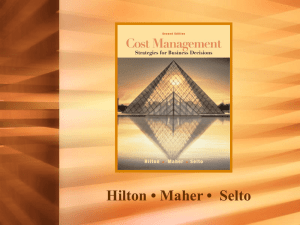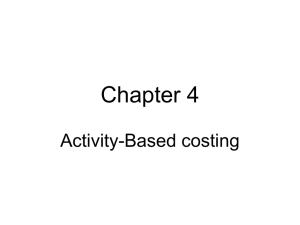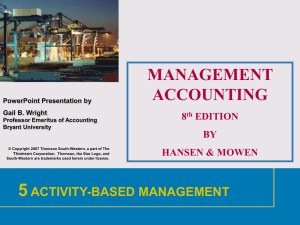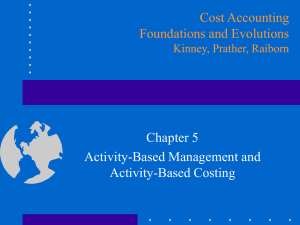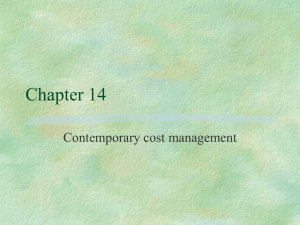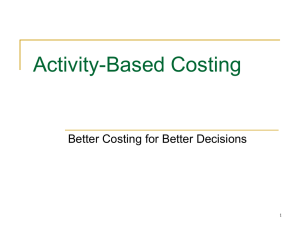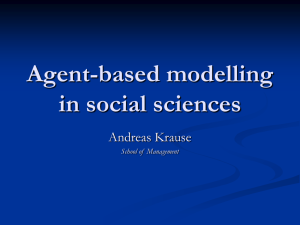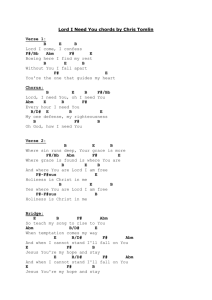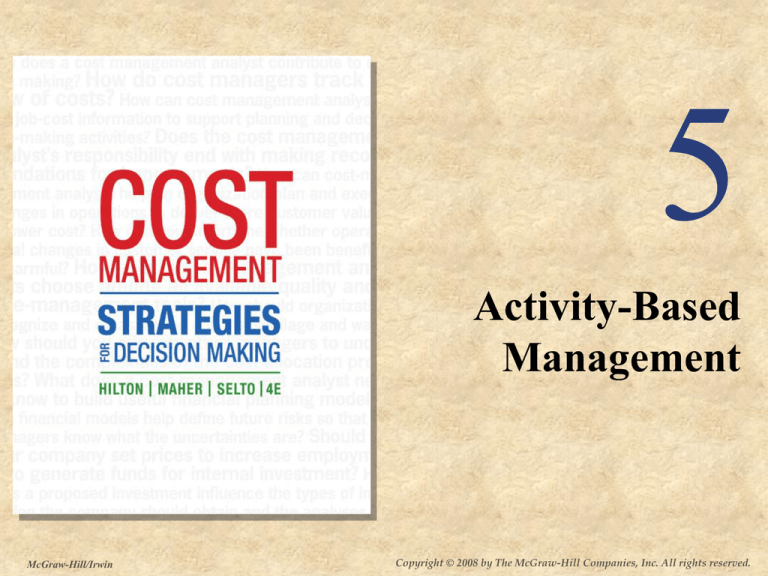
5
Activity-Based
Management
McGraw-Hill/Irwin
Copyright © 2008 by The McGraw-Hill Companies, Inc. All rights reserved.
5-2
Learning Objective 1
5-3
Activity-Based Management (ABM)
Evaluates the
costs and values
of process
activities . . .
ActivityBased
Costing
+
ValueAdded
Analysis
. . . To identify
opportunities
to improve
efficiency.
• Process improvements
=
• Improve customer value
• Reduce costs
5-4
ABC vs. ABM
ABC
An improved understanding of the way
resources are used
in the current
processes.
Measures product
costs more
accurately by
analyzing costs
associated with
identified activities
in the processes.
ABM adds:
Identifies valueadded and non-valueadded activities.
Identifies the customerperceived value of each
activity.
?
Identifies opportunities to
enhance value-added
activities and reduce or
eliminate non-value-added
activities
5-5
Learning Objective 2
5-6
Combination of ABC And Target
Costing
Determine target selling price per unit
Determine target cost, per unit and in
total.
Determine target profit
Deduct target return on sales
Result is target cost
Compare target cost to currently
feasible total cost.
The difference is the cost reduction
target
Redesign products and processes to
achieve the cost reduction target.
Contract sales
price
Estimate based
on market
analysis
Competitors’
pricing
5-7
Combination of ABC And Target
Costing
Megaburger Promotional Toys
Target
cost =
Market
price less
Return on
sales
Expected contract price per unit
Less required return on sales
Target cost per unit
Multiplied by monthly sales of 20,000 units
Target cost for one month
20%
$17.00
3.40
$13.60
20,000
$272,000
5-8
Combination of ABC and Target
Costing
Exh.
5.2
Megaburger Promotional Toys
Estimated
Cost
1. Unit-level costs
2. Batch-level costs
3. Product-level costs
4. Customer-level costs
5. Faculty-level costs
Monthly currently feasible costs
Monthly target cost
Monthly cost reduction target
Cost reduction target (in %)
$
$
$
240,000
6,000
44,000
11,000
20,400
321,400
272,000
49,400
15.4%
By comparing
the target cost
to the currently
feasible costs,
we can
determine the
amount that
costs need to
be reduced.
5-9
Learning Objective 3
5-10
The Importance Of CustomerPerceived Value
Activities
Create outcomes
and consume resources
VALUE-ADDED ACTIVITIES
enhance the value of products
and services in the eyes of
the customer while meeting
the goals of the organization.
NON-VALUE-ADDED
ACTIVITIES
do not contribute to customer
perceived value.
5-11
Eliminating Non-Value-Added
Activities
Why do organizations have incentives
to eliminate non-value added activities?
Competitors are
constantly striving
to create more value
for customers at
lower cost.
Competition can
appear quickly.
The organization can
apply the freed-up
resources to valueadded activities or
distribute them to the
owners and
employees of the
organization.
5-12
Likely Sources of Non-Value-Added
Activities
Producing defective products
Producing to
build up
inventory
Waiting time
for processing
Time and effort
to move products
from place to place
Transporting
workers to
work sites
5-13
Identifying Value-Added Activities
The test for valueadded activities
Would an external
customer encourage
the organization to do
more of the activity?
YES
Would the organization
be more likely to
reach its goal by
performing that activity?
If the answer
is “yes” to
both it is
value-added.
YES
5-14
Identifying Value-Added Activities
The test for value
added activities
Would an external
customer encourage
the organization to do
more of the activity?
YES
NO
Would the organization
be more likely to
reach its goal by
performing that activity?
If the answer
If the answer is
is “yes” to
“no”, it is nonboth it is
value-added.
value-added.
YES
NO
5-15
How Should An Organization
Measure Value-Added?
1
2
NONVALUEADDED
3
4
5
VALUEADDED
Rate on a scale of 1 to 5
Necessary Activities
Neither value-added nor non-value-added
Technological
Requirements
Policy
Requirements
Regulatory
Requirements
5-16
Who Should Perform The
Measurement Activity?
Use a team
approach
Everyone’s knowledge is
limited.
Everyone is potentially biased
in his or her response.
5-17
Tasks Required by Activity-Based
Management
Twin objectives
of
ABM
Identify non-value-added
activities to be eliminated
or reduced.
Identify value-added
activities to be enhanced.
Redesign processes to eliminate wasteful spending on
non-value-added activities.
5-18
Sorting Activities By Cost
And Value
Exh.
5.4
Megaburger Promotional Toys
Sorting activities by value and costs, we can identify oversupplied
non-value-added activities and undersupplied value-added
activities. By focusing on non-value-added activities (low-value
activities) with high costs, we can improve efficiency.
Customer Value
Activity Cost Percentage
5 (highest value added)
$100
3.3%
4
0
0.0%
Most costs are
3
40.0%
for non-value- 1,200
added activities
2
700
23.3%
1 (lowest value added)
1,000
33.3%
Total (rounded)
$3,000
100.0%
5-19
Learning Objective 4
5-20
Exh.
5.5
Identifying Opportunities for
Improvement
Megaburger Promotional Toys
Sub-Activity
Trim excess
plastic
Recycle
trimmings
Put piece in
box
Log out
completed
order
Move order to
warehouse
Register order
in inventory
Total elapsed
time
Before Process
Improvements
Elapsed Time:
83 min.
60 min.
25 min.
30 min.
60 min.
28 min.
286 min.
Before Process
Ask “Why?” for each
Improvements
step in the process.
Elapsed Time:
Why do employees need to trim
0 min. from molded products?
excess plastic
0 min. and product function
Why#1: Appearance
requires removal of the excess.
25 min.
Why#2: Under
high-injection pressure, plastic
leaks from the edges of the mold.
Why#3: High pressure is required to mold the
products
15.1
min.properly.
Why#4: The design of the molds permits
leakage.
30 min.
Why#5: The molds are based on old designs.
12.1 min.Rework or replace old
SOLUTION:
molds with improved molds to eliminate
the 82.2
need min.
for trimming and recycling.
5-21
Exh.
5.5
Identifying Opportunities for
Improvement
Megaburger Promotional Toys
Sub-Activity
Trim excess
plastic
Recycle
trimmings
Put piece in
box
Log out
completed
order
Move order to
warehouse
Register order
in inventory
Total elapsed
time
Before Process
Improvements
Elapsed Time:
83 min.
60 min.
25 min.
30 min.
60 min.
28 min.
286 min.
Before Process
Ask “Why?” for each
Improvements
step in the process.
Elapsed Time:
Why0aremin.
we spending so much time on
non-value-added record keeping and
the0 correction
of recording errors?
min.
25 min.
SOLUTION: Install a bar-coding
system to mark and track all
orders electronically.
15.1 min.
30 min.
A bar-coding system creates a
unique bar code for each order
12.1 min.
and allows the company to mark
and track
82.2
min. all orders electronically.
5-22
Exh.
5.5
Identifying Opportunities for
Megaburger Promotional Toys
Improvement
Sub-Activity
Trim excess
plastic
Recycle
trimmings
Put piece in
box
Log out
completed
order
Move order to
warehouse
Register order
in inventory
Total elapsed
time
Before Process
Improvements
Elapsed Time:
After Process
Improvements
Elapsed Time:
83 min.
0 min.
60 min.
0 min.
25 min.
25 min.
30 min.
15.1 min.
60 min.
30 min.
28 min.
12.1 min.
286 min.
82.2 min.
After process
improvements,
total elapsed
time has been
reduced to
82.2 minutes.
If we assume a
cost of $10 per
hour, what is
the cost
savings?
5-23
Exh.
5.5
Identifying Opportunities for
Megaburger Promotional Toys
Improvement
Sub-Activity
Trim excess
plastic
Recycle
trimmings
Put piece in
box
Log out
completed
order
Move order to
warehouse
Register order
in inventory
Total elapsed
time
Before Process
Improvements
Elapsed Time:
After Process
Improvements
Elapsed Time:
83 min.
0 min.
60 min.
0 min.
25 min.
25 min.
30 min.
15.1 min.
60 min.
30 min.
28 min.
12.1 min.
286 min.
82.2 min.
Time Saved:
286 min.
- 82.2 min.
203.8 min.
÷ 60 min/hr
3.397 hrs.
Cost Savings:
3.397 hrs.
× $10/hr.
$33.97
5-24
Learning Objective 5
5-25
Costs of Resources Used versus
Resources Supplied
The cost of supplying a resource is often
greater than the cost of using a resource.
The difference is an unused capacity cost.
Example: A pizza cook is paid $7.00 per hour and can make 10
pizzas per hour. If 10 pizzas are ordered in an hour, then the
labor cost is actually $.70 per pizza. However, if only 5 pizzas
are ordered in an hour, what is the cost per pizza?
The cost of labor supplied is $7.00 per hour. The cost of labor
used is only $3.50 when 5 pizzas are ordered, still $.70 per pizza.
The remaining $3.50 is the cost of unused capacity.
5-26
Capacity Utilization
Cost of all resources
provided, whether
used or not.
Unused
Capacity
=
Resources
Supplied
Cost of all resources
actually used by the
productive process.
–
Resources
Used
An indication of potential cost
savings or possible expansion
without additional costs.
5-27
Learning Objective 6
5-28
Implementation Of Activity-Based
Costing & Management
The Focus of
ABC
The Focus of
ABM
Developing improved
product or service costs
given current processes
Identifying opportunities
for improving processes
Consider the benefits and the costs
5-29
Implementation Of Activity-Based
Costing And Management
What Organizations Adopt ABC and
ABM?
Companies facing price competition.
Companies producing many different,
complex products from common
facilities.
5-30
Can You Be Sure That ABC
And ABM Will Be Successful?
What is the scope of the ABC or ABM project?
Pilot Project
Organization-wide
System
What is a “pilot
project”?
Why use a “pilot
project”?
A project of limited
scope that is intended
to be a small-scale
model of an
organizational system.
Anticipate the linkages
across departments,
groups and processes.
Anticipate the data
gathering and reporting
requirements.
5-31
Can You Be Sure That ABC
And ABM Will Be Successful?
What resources
are necessary?
Management
Commitment
Educate top
management
as to
cost/benefits
Technology
Begin with
existing
commercial
software
Personnel
and Time
Significant projects
will require a threeto four-person,
cross-functional
team at least four
to six months of
full-time effort
5-32
Can You Be Sure That ABC
And ABM Will Be Successful?
How can you anticipate and overcome
resistance to change?
Education and Training
Prevent or Minimize
Resistance by:
Incentives that Encourage
and Reward Change
Widespread Sponsorship
and Participation
Effects of culture
Be Sensitive to Differences
in National Cultures
5-33
Can You Be Sure That ABC
And ABM Will Be Successful?
How do you gather information?
ABC and ABM require information that is not normally
available from an organization’s information systems.
Observation
This
information can
be generated
by:
Interview
Survey
5-34
Can You Be Sure That ABC
And ABM Will Be Successful?
How Should you Perform the Analysis and
Make Recommendations?
Though top managers ultimately have the
responsibility for authorizing and effecting major
changes, the analysis team is best prepared to
analyze the data and make recommendations.
The team is ultimately familiar with the data, its
strengths and weaknesses.
Empowering and requiring the team to make
recommendations gives the control and
accountability for the entire project
5-35
Some Notes on Resource
Consumption Accounting (RCA)
5-36
Managers Comment about Cost Reports
How do I get
my schedule
in synch with
these budget
estimates?
Some staff have
just been hired,
but there is no
allowance for
the learning they
have to do.
Why did they
call our idle
time estimates
lost time?
5-37
Shortcomings of
Activity-Based Management
It pays primary attention to the cost (in
dollar values) of an organization’s
personal and physical resources.
Activity analyses often assume that
those costs can be treated as if they
were all variable.
It assumes uniformity among the
human and physical resources
involved in performing activities.
It is still primarily concerned not with
operational effectiveness, but with
measuring the cost of products (as is
financial accounting).
5-38
A Suggestion for Improvement
Account for personal and physical
resources at the beginning of the
budgeting process.
Measure them first in terms of their
contributions to work output (productive
hours, capacity, technology).
Chart the cause and effect relationships
among them.
Then, after we know the demand for
these resources, we may assign costs
(fixed and proportional) to the units of
output of our goods and services.
5-39
-- Not Spoken Here!
Those anonymous, “uncontrollable” costs
are no longer added together and
allocated at the end of a budgeting
process, but identified at the beginning.
That is because the primary goal is not
cost accumulation but resource planning
and management.
This integrating technique is called
Resource Consumption Accounting.
It is also known as Activity-based
Resource Planning, because it enhances
Activity-based Budgeting.
5-40
Advantages of This Approach
Strategic
Plan
It simulates more closely the way
operations managers plan their
activities in response to future
needs.
Traditional cost accounting becomes
smoothly integrated into their
resource planning and scheduling
activities.
Reports and analyses focus on
cause-and-effect relationships and
levels of controllability rather than
formula-based cost assignments.
5-41
Resource Consumption Accounting
Pilot RCA programs are in progress
throughout the U. S.
An organization must have installed
an Enterprise Resource Planning
(ERP) system in order to implement
RCA.
Research results are available from
CAM-I at a dedicated website:
www.rcainform.org.
IMA has published numerous articles
about RCA, which are available at
www.imanet.org/
5-42
End of Chapter 5

